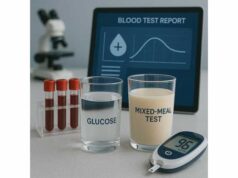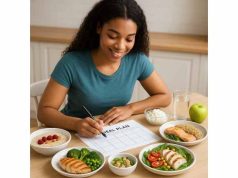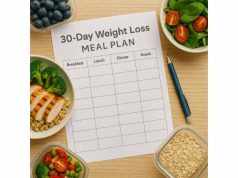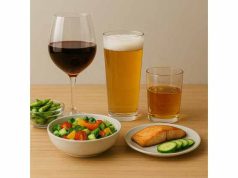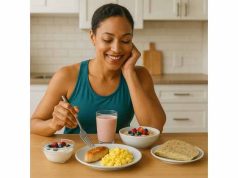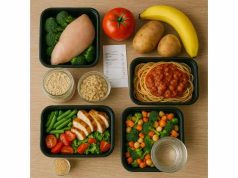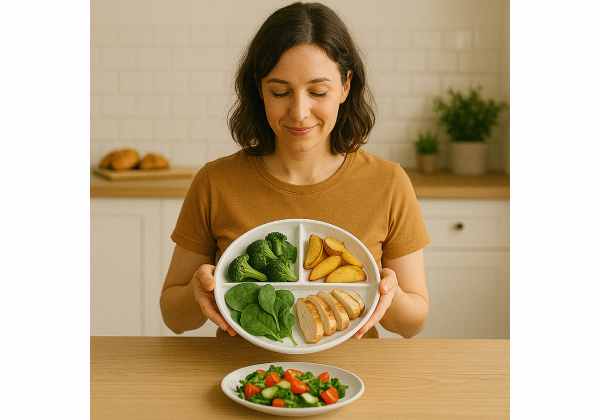
Portion size is the bridge between nutrition advice and what actually lands on your plate. You can know your calorie needs and still overshoot if your servings are larger than you think. This guide turns portion control into a repeatable routine: a clear plate method for balanced meals, hand-size visuals you can use anywhere, and adjustments for goals, hunger, and activity. If you want help setting calorie targets and mapping meals across a week, start with our overview of calorie targets and meal planning. Then come back here to learn how to plate food fast, eyeball portions without a scale, and troubleshoot common sticking points. The goal is simple: eat satisfying meals that gently keep you in a calorie deficit—without counting every bite.
Table of Contents
- Portion sizes and the plate method
- How to build a weight-loss plate
- Hand portions and visual cues
- Portion mistakes and fixes
- Adjusting portions for your goals
- Evidence on portion control
- Portion templates and meal ideas
- Frequently Asked Questions
Portion sizes and the plate method
Portion control is not about tiny meals; it is about right-sizing. The plate method is a visual system that helps you build balanced meals that fit your calorie needs without measuring. At its core:
- Half the plate: non-starchy vegetables (salad greens, broccoli, peppers, tomatoes, mushrooms).
- One quarter: protein (fish, chicken, tofu, eggs, lean beef, tempeh, Greek yogurt).
- One quarter: quality carbohydrates (potatoes, whole grains, beans, fruit).
- Add: a thumb of healthy fats (olive oil, nuts, seeds) or a thin smear of sauce or dressing.
Why this works:
- ** Volume and fiber** from vegetables increase stomach stretch and satiety with very few calories.
- Protein helps you stay full and protects lean mass while losing fat.
- Carbohydrates fuel movement and keep meals satisfying; choosing whole-food sources steadies energy.
- Fats carry flavor and improve satisfaction so smaller portions feel complete.
Plate size matters. A standard dinner plate ranges from 9 to 12 inches (23–30 cm). Larger plates make portions look smaller and encourage overserving. If you routinely overeat, use a 9–10 inch (23–26 cm) plate and a smaller bowl for carb-dense foods like pasta or rice.
Liquid calories and extras. A beautifully portioned plate can be undone by sugary drinks, large pours of oil, or heavy dressings. Measure oils at the stove (a teaspoon looks small but adds ~40 calories). Keep dressings to 1–2 tablespoons or thin with lemon or vinegar.
When to use a scale. You do not need one daily. A quick two-week calibration phase helps: weigh your usual servings of rice, pasta, cereal, and nuts to learn what ½ cup, 1 cup, or 30 g looks like. After that, rely on visuals and only recheck when portions creep up.
Eating pace. Slower meals improve portion awareness. Put your fork down between bites, sip water, and check in halfway: are you satisfied or just finishing out of habit?
If you need a refresher on safe pacing, behavior change, and weekly targets, skim our guide to safe weight-loss basics before you overhaul your plate.
How to build a weight-loss plate
Think of each meal as a quick assembly line. You choose a plate, fill the sections, and adjust for hunger and activity. Here is the workflow that makes portion control automatic.
1) Start with vegetables (half the plate).
Pick two or more colors. Raw salads, roasted veg, sautéed greens, or vegetable soup all count. Aim for 2 fistfuls at lunch and dinner. If breakfast is savory, add tomatoes, mushrooms, or spinach; if sweet, consider a side of fruit instead.
2) Add a palm of protein (quarter).
Most adults need 25–40 g per meal for satiety. A simple cue is one palm (women) to two palms (men) per meal—adjust to your appetite and goals. Rotate lean meats, fish, eggs, tofu, tempeh, beans, Greek yogurt, or cottage cheese.
3) Add a cupped hand of carbs (quarter).
Choose slow-digesting carbs: potatoes, brown rice, quinoa, whole-wheat pasta, oats, beans, lentils, or fruit. One cupped hand (women) to two cupped hands (men) is a solid default. On active days, add a half-cup more; on lower-activity days, stick to the base.
4) Add a thumb of fats.
Use 1–2 thumbs (women/men) of olive oil, nuts, seeds, avocado, pesto, or nut butter. If your protein is naturally fatty (salmon, higher-fat beef), you can reduce added fats.
5) Plate order and plating tricks.
Serve vegetables first to define space. Keep starchy foods in a small bowl or side compartment to stop “spreading.” Use tongs for salads (lighter) and a ladle for stews (more precise).
6) Breakfast option if you prefer bowls.
Use the same ratios in a bowl: half fruit or vegetables, a palm of protein (eggs, yogurt, tofu), a cupped hand of whole grains (oats, muesli), and a thumb of fats (nuts, seeds). Sweet breakfasts benefit from extra protein to prevent mid-morning hunger.
7) Drinks, sauces, and desserts.
Default to water, unsweetened tea, or black coffee at meals. If you want dessert, plan it like a side: a small square of dark chocolate, fruit, or a yogurt cup. Keep it 200 calories or less most days.
If you are matching portion balance to your protein, carb, and fat targets, review our quick primer on macro ratios and plug your plate into those numbers without counting every gram.
Hand portions and visual cues
Your hands travel with you—restaurant, office, or holiday table—and scale fairly well with body size. Use these cues to portion meals anywhere without a scale.
Core hand cues
- Protein: 1 palm (women) or 2 palms (men) per meal. Palm = length, width, and thickness of your palm (no fingers).
- Chicken, fish, tofu, tempeh, lean beef, eggs (2–3 eggs ≈ 1 palm), Greek yogurt (¾–1 cup ≈ 1 palm).
- Carbohydrates: 1 cupped hand (women) or 2 cupped hands (men).
- Cooked grains, potatoes, pasta, beans, lentils, fruit.
- Fats: 1 thumb (women) or 2 thumbs (men).
- Oils, nut butters, mayonnaise, pesto, seeds.
- Vegetables: 2 fists per meal when possible; at minimum, 1 fist.
Dining out visuals
- Steak or chicken breast: a deck of cards ≈ small palm (~3–4 oz cooked).
- Fish fillet: checkbook or smartphone footprint ≈ 4–6 oz.
- Pasta: a tennis ball ≈ ~1 cup cooked; restaurant servings are often 2–3 cups.
- Rice: a small fist ≈ ~¾ cup cooked.
- Cheese: two dice ≈ ~1 oz; a matchbox ≈ ~1.5 oz.
- Nuts: a golf ball ≈ ~2 tbsp (~100–120 calories, depending on type).
Breakfast portions in everyday objects
- Oats: ½ cup dry (about a hockey puck volume when cooked thicker).
- Muesli/granola: ⅓ cup dry fits in a cupped hand; add yogurt and fruit to increase volume without doubling calories.
- Peanut butter: a thumb-tip (teaspoon) on toast vs. a full thumb (tablespoon) in a smoothie.
Snacks and mini-meals
- Greek yogurt cup (170 g / 6 oz): 1 palm of protein; add berries (½–1 cup) and 1 tsp nuts for texture.
- Cottage cheese (¾ cup): 1–1.5 palms; pair with cucumber or fruit.
- Edamame (¾ cup shelled): 1 palm; salt lightly.
- Popcorn (air-popped): 3 cups ≈ a large mixing bowl’s bottom layer; season with herbs instead of oil.
When visuals are not enough
- Highly processed foods pack more calories into smaller volumes. Chips, crackers, pastries, and creamy sauces require extra caution. Use labeled servings for a week to recalibrate your eye.
- Drinks hide calories. Measure juice, specialty coffee, and alcohol once to learn glass sizes; then pour with intention.
Want more ideas that fill a plate without many calories? Pull inspiration from our roundup of high-volume foods that create satisfying portions.
Portion mistakes and fixes
Portion habits often drift. The bowl gets bigger, the oil pours longer, and your “usual” becomes 30–40% more than it was. Here is how to spot and fix the most common issues.
1) Using restaurant plates at home
Large dinnerware makes reasonable portions look small.
Fix: Eat most meals on 9–10 inch plates and use smaller bowls for grains and pasta. Save the big platters for vegetables and salad.
2) Free-pouring oils, dressings, and sauces
A few extra seconds at the bottle can add 100–200 calories.
Fix: Use a teaspoon at the stove; switch to spray bottles for oil; thin dressings with lemon or vinegar to stretch them.
3) “Healthy” foods in huge portions
Nuts, avocado, hummus, and whole-grain products are nutrient-dense and easy to overserve.
Fix: Measure once, learn the look, and switch to single-thumb portions of fats at meals. Pair calorie-dense foods with big veg servings.
4) Bottomless snacks
Bags and boxes remove visual stopping points.
Fix: Pre-portion snacks into small containers. Put the bag away before you sit down. If you want more, take a deliberate second portion instead of grazing.
5) Skipping protein at breakfast
Low-protein mornings lead to oversized dinners.
Fix: Anchor breakfast with 25–40 g protein (eggs, yogurt, tofu). This steadies appetite and makes lunch and dinner portions easier to control.
6) Eating too fast
Speed dulls fullness signals.
Fix: Set a 12–15 minute minimum for meals. Put utensils down between bites, sip water, and pause halfway to reassess.
7) Letting the weekend rewrite your portions
Social meals can blow up portions by 500–1,000 calories per day.
Fix: Use the plate method at restaurants, order vegetables first, share starch-heavy sides, and plan dessert as your carb quarter if you want it.
For a deeper look at pitfalls across your diet, see our guide to common diet mistakes and which ones to fix first.
Adjusting portions for your goals
The plate method is a starting point. Your activity level, appetite, and goals shape the final plate. Here is how to tweak portions without losing balance.
If you are very active or train hard
- Keep the half-plate vegetables and palm(s) of protein.
- Expand carbs by ½–1 cupped hand at meals around workouts (rice, potatoes, fruit, oats).
- Use two thumbs of fats only when meals feel too light or you struggle to stay full.
If you sit most of the day
- Keep vegetables at ½ plate (or more).
- Stick to 1 cupped hand of carbs at meals; add more only when you feel low energy or irritable.
- Emphasize lean proteins and soups/salads for volume.
If hunger stays high
- Increase protein by 5–10 g per meal and add a fist of high-fiber vegetables or a ½ cup of beans.
- Check sleep and hydration; mild dehydration can masquerade as hunger.
If you are petite or have low energy needs
- Use a salad plate (8–9 inches) to maintain visual balance with smaller absolute amounts.
- Keep the same ratios but make each section smaller.
If you prefer low-carb
- Keep protein constant.
- Shift a portion of carbs to non-starchy vegetables and increase fats to 1–2 thumbs as needed for fullness.
- Review our overview of daily carb targets to choose a range that fits your preferences.
If you are plant-based
- Mix legumes with soy foods to raise protein quality.
- Use larger palms for tofu/tempeh or add a protein shake to hit targets.
- Sprinkle seeds or nuts deliberately (thumb portions) for flavor and staying power.
If weight loss stalls
- Do a one-week “portion audit”: weigh starches, fats, and treats.
- Trim carbs or fats by 10–20% per meal while keeping protein and vegetables steady.
- Recheck after two weeks; adjust further only if needed.
Evidence on portion control
Portion size influences intake more than most people expect. When serving sizes double, people tend to eat 20–30% more without noticing. The plate method and visual cues counter this by pre-limiting the most calorie-dense foods and expanding low-calorie items that enhance fullness.
Why this matters for fat loss:
- Energy density: Foods with lots of water and fiber (vegetables, beans, many fruits) provide large portions at lower calories. Filling half the plate with these options means you can eat more volume while still reducing energy intake.
- Protein anchoring: Meals with 25–40 g of protein improve satiety and help retain lean mass while dieting. This shifts weight loss toward fat rather than muscle.
- Automaticity: Visual rules reduce decision fatigue. When you plate the same way at home, at work, and when dining out, you avoid the “portion creep” that slowly erodes a calorie deficit.
- Behavioral feedback: Smaller plates and bowls create a natural stopping point, prompting you to pause and assess hunger before taking seconds.
The best results come when portion strategies sit inside a calorie deficit and a week-to-week plan. If you are building that plan, review our practical guide to deficit strategies that reduce hunger while you cut calories.
Portion templates and meal ideas
Turn the rules into meals you can repeat. Use these templates as mix-and-match blueprints for breakfast, lunch, dinner, and snacks. Each follows the plate method and typical hand portions.
Breakfast (choose one)
- Egg and veg skillet
- 2–3 eggs (1–1.5 palms), 1–2 fists mixed vegetables, 1 cupped hand roasted potatoes or whole-grain toast, 1 thumb olive oil.
- Add salsa or herbs for brightness.
- Greek yogurt bowl
- 1 cup Greek yogurt (1–1.5 palms), ½–1 cup berries, ⅓ cup muesli or oats (½ cupped hand), 1 tsp chopped nuts (half a thumb).
- Cinnamon, vanilla, or lemon zest elevate flavor without many calories.
- Tofu scramble
- 150–200 g tofu (1–1.5 palms), mushrooms and spinach (2 fists), 1 cupped hand roasted sweet potato, 1 thumb avocado.
Lunch (choose one)
- Big salad with protein
- 2 fists salad greens + assorted vegetables, 1–2 palms grilled chicken or chickpeas + tofu combo, 1 cupped hand quinoa, 1 thumb olive oil + vinegar.
- Keep cheese to dice-size portions (1 oz) if used.
- Soup and sandwich
- Vegetable or bean soup (2 ladles, mostly vegetables), half sandwich on whole-grain bread with 1 palm lean protein, 1 thumb spread.
- Add fruit if hungry.
- Stir-fry bowl
- 2 fists mixed vegetables, 1–1.5 palms shrimp or tempeh, 1 cupped hand rice, 1 thumb sauce (measure soy sauce + a little honey or sesame oil).
Dinner (choose one)
- Fish, potatoes, greens
- 1–1.5 palms salmon or white fish, 2 fists broccoli and carrots, 1 cupped hand baby potatoes, 1 thumb olive oil or pesto.
- Taco plate
- 2 small tortillas (½–1 cupped hand), 1–1.5 palms seasoned chicken or beans + tofu, 2 fists peppers/onions/cabbage slaw, 1 thumb guacamole, salsa freely.
- Pasta the plate-method way
- 1 cupped hand cooked whole-wheat pasta, 1–1.5 palms turkey or lentil Bolognese, 2 fists zucchini and mushrooms, 1 thumb Parmesan.
- Keep pasta in a small bowl and heap vegetables on the plate.
Smart snacks (100–250 calories)
- 170 g Greek yogurt with ½ cup berries (1 palm protein, high volume).
- ¾ cup cottage cheese with cucumber and pepper.
- 2 hard-boiled eggs and cherry tomatoes.
- 3 cups air-popped popcorn with herbs.
- Edamame (¾ cup shelled) with sea salt.
Portioning seconds and desserts
- If still hungry after a plate, wait 10 minutes, drink water, then take vegetables or protein first.
- For dessert, plan a half-portion: share, order the smallest size, or keep bites to the size of two dice of chocolate or a golf ball of gelato.
These templates are flexible. Swap proteins and vegetables freely, and adjust carb portions by ½ cupped hand based on activity and hunger.
Frequently Asked Questions
What size plate should I use for weight loss?
Most people do well with a 9–10 inch (23–26 cm) plate. It keeps portions visually satisfying while limiting overserving. Use small bowls for grains and pasta, and large bowls for salads and vegetables to increase volume without many calories.
How can I measure portions without a scale?
Use your hands: palm for protein, cupped hand for carbs, thumb for fats, and fist for vegetables. These cues scale with body size and work in restaurants, at home, and when traveling. Calibrate tricky foods for one week, then rely on visuals.
Should I count calories or use the plate method?
You can do either. Counting offers precision but takes time. The plate method delivers fast, repeatable decisions that keep you close to your targets. Many people start with the plate method and use calorie tracking briefly when progress stalls.
How do portions change on low-carb days?
Keep protein the same. Shift the carb quarter toward extra non-starchy vegetables and raise fats to 1–2 thumbs as needed for fullness. Choose fibrous carbs when you include them—beans, lentils, berries, and root vegetables in measured amounts.
What about desserts and snacks?
Plan them. Treat dessert like a side and keep most daily snacks to 100–250 calories with protein and fiber. Pre-portion sweets, use small plates, and enjoy slowly. If cravings spike, add more protein and vegetables at meals to steady appetite.
Do I need different portions on workout days?
Around workouts, increase carbs by ½–1 cupped hand at the meals before and after training. Keep vegetables at half the plate and protein at 25–40 g per meal. On rest days, return to your base plate and let hunger guide small adjustments.
References
- Downsizing food: a systematic review and meta-analysis examining the effect of reducing served food portion sizes on daily energy intake and body weight. 2022. (Systematic Review/Meta-analysis)
- Impact of energy density on energy intake in children and adults: a systematic review and meta-analysis of randomized controlled trials. 2022. (Systematic Review/Meta-analysis)
- Protein intake and body weight, fat mass and waist circumference: an umbrella review of systematic reviews for the evidence-based guideline on protein intake of the German Nutrition Society. 2023. (Umbrella Review)
- Portion, package or tableware size for changing selection and consumption of food, alcohol and tobacco. 2015. (Cochrane Review)
Disclaimer
This article offers general nutrition guidance for portion control and weight management. It does not replace personalized medical advice, diagnosis, or treatment. If you have a medical condition, take prescription medications, are pregnant, or are breastfeeding, speak with your healthcare professional before changing your diet.
Share and follow
If this visual guide simplified portion control, consider sharing it with a friend who is planning meals. For steady, research-based tips, follow us on the social network you use most.

